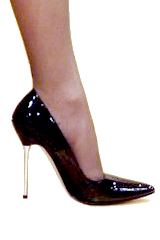Have you lost your arches? Have you been told you have flat feet? Reduce your stress level because the situation may not be that desperate. Flat feet, also referred to as pes planus or fallen arches, are a condition where the arch of the foot collapses. It can affect one or both feet. Babies are born with flat feet and it takes a few years for bones, tendons and ligaments to strengthen and grow, forming the foot’s arch. In most instances the arch develops in childhood, usually by age five or six, but in some cases, the arch of the foot never fully develops. About twenty percent of the world’s population has flat feet, or some degree thereof because their arches never completely formed. This type of flat foot is rarely problematic, and would not likely require treatment.
Flat feet that develop in adults as a result of injury, illness, stress or aging are referred to as Adult Acquired Flat Foot. Factors contributing to the cause of this type of flat feet include weight, high blood pressure and diabetes. If you acquire flat feet as an adult, they will probably stay that way. Strength training of the muscles in the foot may help to retain or regain normal function, but the foot muscles are short, and most likely the arch would not re-develop.
If you want to monitor the condition of your arches, wet your feet then stand on a smooth surface. When the footprint shows a lot of sole, it indicates a flat foot. What do flat feet mean to you? Flat feet usually do not cause pain and would not require treatment. However, if you are in the low percentage of people that experience pain in the foot, ankle or lower leg, see your podiatrist. He may recommend orthotics, exercises or physical therapy to help strengthen your feet. If your doctor prescribes orthotics you will probably need to use them for the remainder of your life. If much correction is required, it will likely be done gradually, over a period of time, allowing you to adjust in increments.
If you have pain that may be attributed to flat feet, call Dr. Blaakman. He will be able to evaluate and diagnose you and provide a treatment plan just right for you. Whether it involves exercises or orthotics, it will help you on your way. For more information, or to set up an appointment, please call Dr. Blaakman at (877) 941-FEET (3338).
If you have a story about your flat feet, please share below…
References:
http://www.mayoclinic.com/health/flatfeet/DS00449/DSECTION=causes
http://en.wikipedia.org/wiki/Flat_feet
Showing posts with label Haglund's deformity. Show all posts
Showing posts with label Haglund's deformity. Show all posts
Monday, April 30, 2012
Thursday, March 1, 2012
Haglund’s Deformity-A Walking Nightmare
 Image via WikipediaHaglund’s deformity, sometimes referred to as the “pump bump” is a bony protrusion in the heel area, which is thought to be caused primarily by pressure from shoes, although there may be other factors involved. Between the bone and the Achilles tendon is a small sac of lubricating fluid which allows for easier movement. A prominent heel bump can squeeze the soft tissue between the bone and the shoe. This can cause inflammation and a build-up of tissue that creates even more pressure.
Image via WikipediaHaglund’s deformity, sometimes referred to as the “pump bump” is a bony protrusion in the heel area, which is thought to be caused primarily by pressure from shoes, although there may be other factors involved. Between the bone and the Achilles tendon is a small sac of lubricating fluid which allows for easier movement. A prominent heel bump can squeeze the soft tissue between the bone and the shoe. This can cause inflammation and a build-up of tissue that creates even more pressure.The most notable symptom of Haglund’s deformity is pain in the back of the heel. The tissue that thickens in this area and forms a callus type buildup doesn’t usually impede function or interfere with walking, but the bursitis, which causes swelling and inflammation, can create a great deal of pain when shoes are worn.
Diagnosis of Haglund’s deformity can usually be made visually, but our office will probably want to get x-rays to have a better picture of how the heel bone is shaped, and rule out other possibilities that might cause your heel pain.
Treatment can be either non-surgical or surgical. However, much of that depends upon your diagnosis. Below are some non-surgical options, which include, but not limited to:
• Taking over-the-counter medications - such as Ibuprofen to reduce swelling and discomfort.
• Icing the area – you can use a towel between ice and skin, and apply it to the inflamed area for 20 minutes, then wait at least 40 minutes before applying again.
• Exercising – this will help relieve tension in the Achilles tendon.
• Heel lifts or heel pads – these may help relieve pressure and lessen irritation.
• Changing your shoes – wearing a backless shoe will help to avoid irritation.
You can find more information by clicking here.
If non-surgical treatments fail to provide relief, surgery may be required. Dr. Blaakman will determine what course of treatment best suits you.
If you have swelling and pain in one or both heels, call our office at (877) 941-FEET (3338).
Related articles
- Is heel pain stopping you from training? (abysmalfitness.com)
- Heel Pain by Foot Health Facts (footandankleclinicsofamerica.wordpress.com)
- T Magazine: Vain Glorious | The Happy Heel (tmagazine.blogs.nytimes.com)
Subscribe to:
Comments (Atom)
